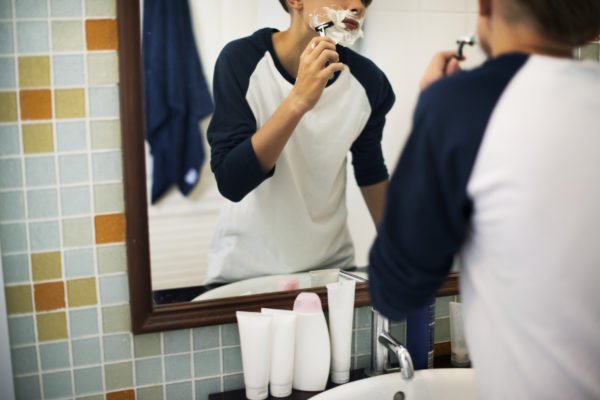
Experts’ Top Tips for Single Mums: How to Ace Son’s First Shave, and Other Milestone Moments

The superheroic antics of the nation’s single mums deserve to be celebrated all year round – but Mother’s Day on Sunday 14th March seems as good a time as any to spotlight some of the challenges they face.
Raising a son without the male parent around as a role model or a go-to for coming-of-age questions can present more than its fair share of tricky conversations, and among these is offering advice for that all-important first shave. During lockdown this will have been even more difficult where sons haven’t been able to see other male role models (like uncles, grandfathers and teachers) in months.
There are around 1.8 million single parents in the UK, and 90% of these are single mums. Just under 3 million children live in single parent families, which is 21% of all children in the UK. That’s a lot of first-time shaves that could be taking place without the guidance of a father figure on hand when it’s needed. So thank goodness for our super mums.
In order to uncover how to navigate those difficult moments, experts at Wilkinson Sword have spoken to parenting experts and adolescent psychologists, and have curated top tips for single mothers approaching their son’s first shave moments, along with 5 steps to achieving the perfect shave.
It’s OK to feel awkward
Feeling awkward about certain things is a natural part of parenting. Nina Farr, author of ‘I Am The Parent Who Stayed’, advises: “These adolescent moments really are no different to the wobbly teeth, grazed knees and friendship blips you’ve already weathered together. Sure, his body is changing, so yes, the boundaries are too. But it’s a slow transition, not a sharp one. It’s our job as parents to help all our children step forward, while we gently step back, but we can’t leave them high and dry. Your son may not say it in words, but he still needs you. If you’re a solo parent then this is more true than ever.”
As a mum you haven’t experienced the same things that your son(s) will, but that doesn’t mean that you can’t be there for them. The most important thing is not to have all the answers but to care for them, offer support and be equipped to point them in the direction of the guidance that they need.
Figure out the right time for you
In puberty, facial hair growth in boys tends to follow a regular pattern where it starts to grow on the upper lip – typically somewhere between the ages of 11 and 15. From there it will start to grow on the cheeks and sideburns too, but everyone’s different so some boys will grow more facial hair than others.
Dr Kate Mason, Child & Adolescent Clinical Psychologist and founder of Roots Psychology Group, notes: “It’s very common for young boys to feel awkward about discussing topics of puberty, their hormones are also changing and they are becoming more self-aware. It doesn’t always matter who is helping them through this, it’s more about the approach that is used. The key is balance – talking about it every minute of the day may make it into a big issue resulting in embarrassment, but dismissing it as being unimportant shuts down the young person’s experience. We need to be validating with regards to how they’re feeling.”
Bringing up the subject
When the right time does come around to discuss the subject with your son, your son may be more open to chatting about this subject than you expect. Natalie Phillips, a member of the British Association for Counselling and Psychotherapy and a psychotherapist working with children, young people and families, says: “In my clinics I have often been surprised at how outwardly emotional teenage boys can become and how they often really want to talk. Keep an open mind where you can, and find opportunities to talk where your son feels comfortable – kicking a ball about, just before bed, or on a walk – this will take any intensity out of the conversation.”
On bringing up the subject of a first shave in the best way, Dr Clair Burley, Chartered Clinical Therapist, who specialises in parenting difficulties, says: “Those milestone moments are times in our child’s life where they actually feel vulnerable. That’s because they are adjusting to the unknown, and are learning. As parents, we need to approach these moments in an open and engaged way, responsive to what our children need. That means neither ignoring, nor dominating, those moments. We do this by watching and noticing our child’s responses to give us feedback as to whether we are approaching the moment appropriately.”
5 steps to a perfect shave
Once you reach the point where you’ve had an open dialogue with your son about shaving for the first time, how do you actually teach him?
Here are the five steps you need to know:
1. Prepare the face to shave
- Wet the skin and hair on the face before shaving in order to soften it. This makes it easier for the blade to move and prevents the build-up of dead skin and dirt.
- Apply shaving cream generously in a circular motion. This will help to make the shave more comfortable by keeping moisture in the hair and skin.
2. Have the right equipment to hand
- Starting with a safety razor and learning the most basic technique is definitely the best way to begin. If you’re dealing with sensitive skin, there are plenty of specialist razors designed to make shaving more comfortable.
- In addition to a good-quality shave gel, have a post-shave balm on hand to reduce irritation – skin is likely to flare up after that very first shave.
3. Be patient and don’t rush with perfecting the technique
- Always shave in the same direction as hair growth. While shaving ‘against the grain’ does aid the razor in getting closer to the skin, it also increases the risk of skin irritation and ingrown hairs, which are not the best start to a lifetime of shaving.
- If the razor cuts the skin (and it can happen) hold a warm washcloth against the affected area until the bleeding has slowed right down, and then continue to stem the flow with a tissue. Within a few minutes most shaving cuts should stop bleeding, and a gentle balm like Vaseline can help to soothe the area.
4. Post-shave aftercare
- Pat damp skin dry gently with a towel after shaving, and use a moisturiser to revive the skin and prevent any lasting irritation.
- Cleaning the blade thoroughly by rinsing it under the tap (don’t bash it on the side of the sink) is also important as this prevents the build-up of hairs and dirt. You should change the razor blades every five or seven shaves to prevent the blades from going blunt and reduce the likelihood of painful ingrown hairs.
5. Figure out a routine that works for him
- There’s no hard and fast rule about how often shaving should be repeated once it’s started. For now, it’s best to be guided by the hair growth and only do it again when it’s needed – this is bound to become more frequent over the coming years.
Further information and support for single mothers:
Gingerbread is a charity that provides advice and practical tips for single parent families
OnlyMums provides support for families through separation
Family Lives provides support to families who are struggling with challenging relationships, debt, and mental wellbeing












































